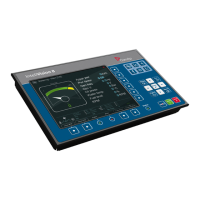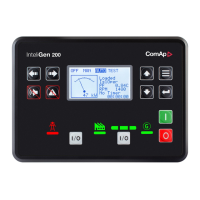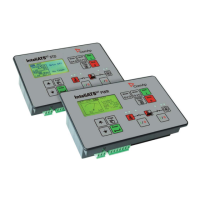IGS-NT-BC, SW Version 1.2.0, ©ComAp – January 2019
IGS-NT-BC-1.2.0 Reference Guide.PDF
Sum of available nominal power
– running gen-sets in PM
Total Load of the
system
Starting sequence Stopping sequence
Bank 1
Priority 1
Bank 2
Priority 2
Bank 3
Priority 3
Bank 3 Running, loaded
Bank 2
#LoadResStrt1
= 25%
#LoadResStrt1
= 25%
Starting
sequence
Running, loaded
Bank 1
Running, loaded
#LoadResStop1
= 37%
Stopped and
ready
Stopped and ready
#LoadResStop1
= 37%
Actual system power [ kW or kVA ]
BO Syst res OK
#LoadResStrt1
= 25%
Time
Time
Starting
sequence
Stopping
sequence
Stopping
sequence
Ready
Ready
Figure: Power management based on relative load reserve
1.2. Automatic priority swapping between the banks
The Bank Controllers are sharing data concerning the running hours and all important information relevant to
the actual load. Thanks to the Automatic priority swapping function the Bank Controllers choose the banks to
be running with consideration of their average running hours and the actual load. The Running hours
equalization (RHE) function keeps a constant maximal difference of bank´s running hours. The Load demand
swap (LDS) function keeps running only the banks with suitable nominal power to avoid inefficient fuel
consumption or bank overload.
At least one Bank Controller in the group must be set as the master for priority optimization
(Pwr Management: Priority ctrl = MASTER). It is possible to have more than one master, the one with
lowest CAN address will play the role of the master and if it is switched off the next one will take the master
role.
Important setpoint: Pwr management: #PriorAutoSwap
The Automatic priority swapping function does not change the setpoint Pwr management: Priority. The
function sets the order of banks by virtual values “engine priority”.

